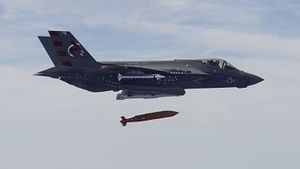A F-35C Lightning II, the carrier-suitable variant of the supersonic fifth-generation Joint Strike Fighter, launched its first 1,000 pound (475 kilogram) AGM-154 Joint Standoff Weapon (JSOW) during weapons trials over the Atlantic Test Ranges on March 23, according to a U.S. Navy press release.
“The F-35 Lightning II Pax River ITF joint team, assigned to the Air Test and Evaluation Squadron (VX) 23 aboard Naval Air Station Patuxent River in Maryland, released one JSOW during the flight,” the statement reads. “Test aircraft, CF-05, cleanly released the 1,000-pound air-to-surface guided glide bomb from an internal weapons bay, thereby maintaining the stealth characteristics of the aircraft.”
The U.S. Navy will drop additional JSOW air-to-surface guided glide bombs throughout 2016. “Working on the multi-phase testing of the F-35 Block 3F capabilities, are U.S. government, military and contractor personnel, and industry partners from Raytheon Systems Ltd.,” The press release offers no specifics on the target of the weapon test, nor did it go into detail what variant of the JSOW was dropped from F-35 internal weapons bay.
The JSOW is a medium range all-weather standoff weapon with an operational range of up to 130 kilometers (80 miles) when launched from high-altitude. The latest version of the JSOW, the JSOW C-1, is purportedly the world’s first network-enabled weapon with a range of over 100 kilometers, according to the bomb’s manufacturer:
The JSOW C-1 is designed to provide fleet forces with the capability and flexibility to engage moving maritime targets, while retaining its robust capability against stationary land targets. The weapon is a modification to the existing JSOW C, which adds a weapon datalink radio and modified seeker software to increase capability for the anti-surface warfare mission.
With the so-called two-way Strike Common Weapon Datalink, along with modified seeker software and an autonomous target capability, the JSOW C-1 is specifically designed to engage moving surface warships and fixed land targets. Given the JSOW’s low-signature/stealth design it can also be used against actively defended targets.
Variants of the JSOW have been used in combat during Operation Desert Fox, Operation Southern Watch, NATO Operation Allied Force, Operation Enduring Freedom, and Operation Iraqi Freedom, according to The Aviationist. Next to the F-35A and F-35C, the JSOW has been integrated on the F-15E Strike Eagle, F-16 Fighting Falcon, F/A-18, AV-8B Harrier aircraft, as well as the B-1B, B-2, and B-52 bombers.
There are three different versions of the F-35 Joint Strike Fighter in existence: The F-35A conventional takeoff and landing variant for the U.S. Air Force; the F-35B short takeoff and vertical landing variant for the U.S. Marine Corps, and the F-35C carrier-based variant for the U.S. Navy.
































